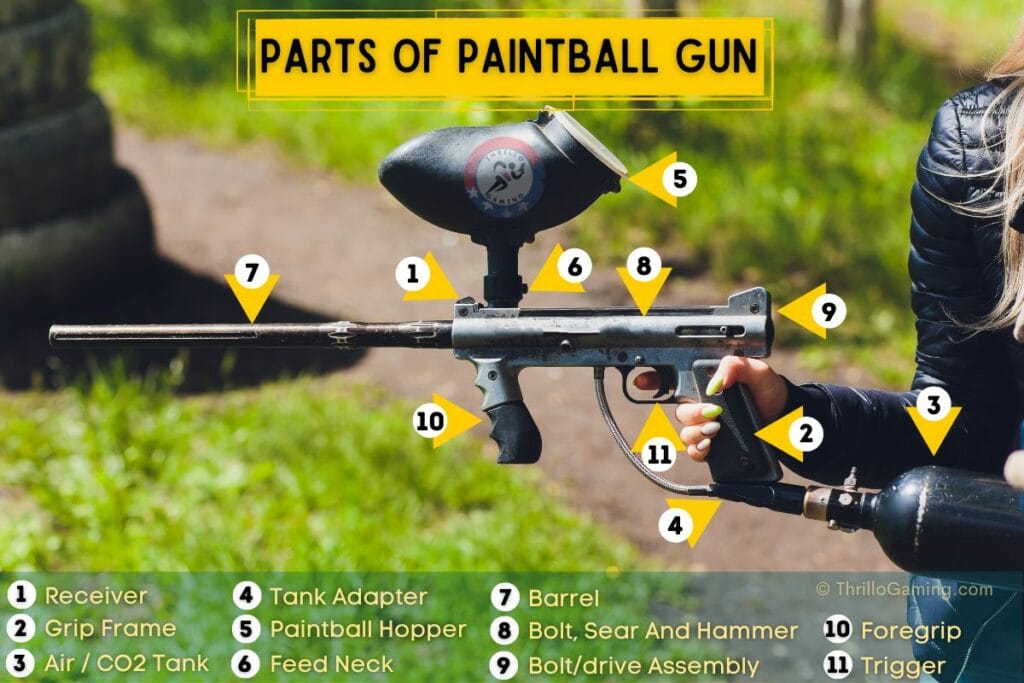Knowing the different parts of a paintball gun is essential for LARP and FPS players who want to improve their accuracy, range, and overall performance on the field.
A paintball gun consists of several key parts, including the barrel, trigger, hopper, and tank. The barrel is where the pellet is loaded and fired, while the trigger activates the firing mechanism to propel the ball out of the barrel using compressed air or CO2 from the tank.
The hopper stores the paintballs and feed them into the gun, while the compressed gas tank is the source of power to propel them. There’s more! Let’s check out all the components of a paintball gun and their functions in detail.

1. Receiver
The main body of the paintball gun where the barrel is attached, is known as its receiver. Usually made from aluminum or other metals, its design may vary a bit from one model to another. The receiver houses several other components – the main spring, power tube, bolt, ball detent, etc.
2. Grip Frame
Like the receiver, the grip frame is another major component of the body. The grip frame of a mechanical paintball gun contains parts like the hand grips and trigger mechanism. An electronic paintball gun also houses electronic components like the circuit board, information screens, buttons, and batteries in this area.
3. Air/CO2 Tank
As you likely know, paintball guns shoot and re-cock using compressed air, carbon dioxide, or nitrogen. This compressed gas or air is stored in a small tank, usually attached to the rear part of the paintball gun. A thin pipeline runs from the air tank to the grip frame, carrying the compressed gas.
Don’t worry, a hydro-tested tank doesn’t cause any issues while playing. It’s safe, not bulky and is much like the rear handle of an actual gun.
4. Tank Adapter
This component is what connects the tank to the grip frame. You have to mount it to the bottom of the grip frame and plug the paintball tank into it. The adapter may have an on/off feature that allows you to turn off airflow without detaching the cylinder from the gun.
5. Paintball Hopper / Magazine
Depending on the type of paintball gun you use, it would have a dedicated hopper to store the ammo. It is a large container attached to the top with a capacity to hold around 200 rounds. It’s usually a gravity-fed system, i.e., gravity pulls the paintballs into the breech.
Some modern paintball guns come with magazines or mags, instead of hoppers. Those magazines are attached at the bottom of the receiver, loaded by a spring mechanism.
6. Feed Neck
Also known as a hopper adapter, the feed neck is the attachment point for the hopper. It lies on top of the gun, precisely above the breech. The feed neck holds the hopper in place and allows the pellets to pass down. The best paintball guns come with clamping or adjustable feed necks to prevent the hopper from falling off.
7. Barrel
Like other toy guns, a paintball gun also has an elongated barrel to discharge the ammunition. A pellet is held in place in the breech while the gas gushes out from behind and shoots it out of the barrel. The barrel’s dimension may vary from one gun to another, influencing the its overall performance.
8. Bolt, Sear And Hammer
Mechanical paintball guns have a bolt, sear, and hammer working in tandem. Cocking the gun pulls back the bolt, which then gets engaged by the sear. Now when you pull the trigger, it’ll trip the sear. This, in turn, releases the hammer, which is powered by a spring. Pushed back into the rear end of the tube, the hammer then opens the valve and releases the pressurized gas to shoot out the paintball pellet.
9. Bolt/drive Assembly
Unlike mechanical paintball guns, electronic ones don’t use the spring and hammer-based mechanism. Instead, they use pneumatic bolt assembly or spool/solenoid/poppet valve assembly, controlled by an electronic circuit board.
10. Foregrip
The foregrip is a vertical, handle-like attachment at the bottom of the front part of the receiver. You’re to hold the foregrip with your off-hand to stabilize the gun and aim your shot correctly. The foregrip is specially designed to ensure a strong grip for the fingers.
Electronic paintball guns might also have an air pressure regulator in the foregrip. You may adjust this regulator to increase or decrease the air pressure and, consequently, the firing velocity.
11. Ball Detent
This small spring-like component is also known as the anti-double feed. As you might guess, its purpose is to prevent a second paintball from feeding into the breech while one is already there. Double-feeding can jam your gun or break the balls by squeezing them too hard.
12. Additional Attachments
Paintball guns may also come with various attachments for different functional purposes. In fact, you can even customize and upgrade your paintball gun by adding attachments of your choice. Sights and scopes are particularly popular and can significantly boost your performance by allowing you to aim better and win the game on your own.
As you might notice, paintball guns and real firearms share several common components. However, they work in completely different ways. Playing with those toy guns is perfectly safe, if you wear protective gear and follow the guidelines.
Now that you have learned about different parts of a paintball gun, you might like to assemble or disassemble it for inspection or maintenance. Watch this video for a quick guide:
If a part breaks or gets damaged, you can replace or repair it at a paintball store. If you wish to upgrade your gun with special attachments, you’ll find what you need at a specialty store or just buy it online.


Great post. This is so informative with accurate information and illustration of paintball gun components. Very help for beginners like me. Thank you Tavish!
I am glad to help you out! Thanks for visiting.